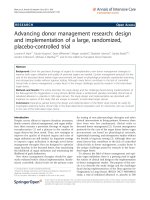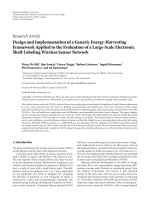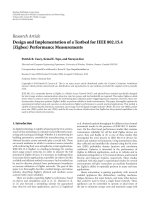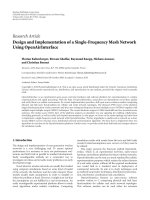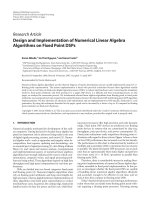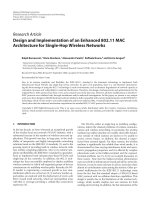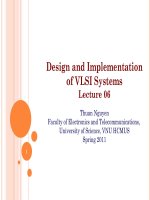Đồ án research, design and implementation of an automatic car parking system
Bạn đang xem bản rút gọn của tài liệu. Xem và tải ngay bản đầy đủ của tài liệu tại đây (3.42 MB, 74 trang )
MINISTRY OF EDUCATION AND TRAINING
HO CHI MINH CITY UNIVERSITY OF TECHNOLOGY AND EDUCATION
FACULTY FOR HIGH QUALITY TRAINING
GRADUATION THESIS
ELECTRONICS AND TELECOMMUNICATION
ENGINEERING TECHNOLOGY
RESEARCH, DESIGN AND IMPLEMENTATION OF
AN AUTOMATIC CAR PARKING SYSTEM
LECTURER: Ph.D. TRAN VI DO
STUDENT: VO HUY HOANG
TRAN NHAT HUY
TRAN DUY KHANH
SKL 0 1 1 1 5 8
Ho Chi Minh City, August, 2023
HO CHI MINH CITY UNIVERSITY OF TECHNOLOGY AND EDUCATION
FACULTY FOR HIGH QUALITY TRAINING
GRADUATION PROJECT
RESEARCH, DESIGN AND IMPLEMENTATION OF AN
AUTOMATIC CAR PARKING SYSTEM
VO HUY HOANG
Student ID : 18146020
TRAN NHAT HUY
Student ID : 18146024
TRAN DUY KHANH
Student ID : 18146033
Major: MECHATRONICS ENGINEERING
Advisor: Dr. Tran Vi Do
Ho Chi Minh City, 7th of August 2023
Disclaimer
The contents of this report reflect the views of the authors, who are solely responsible for
the facts and the accuracy of the material and information presented here. This report is not
a standard, specification or regulation.
Acknowledgements
We are over helmed in all humbleness and gratefulness to acknowledge our depth to all
those who have helped us to put these ideas, well above the level of simplicity and into
something concrete.
I would like to express my special thanks of gratitude to my teacher Tran Vi Do as well as
our principal who gave me the excellent opportunity to do this wonderful project on this
interesting topic, which also helped us in doing a lot of research and we came to know
about so many new things. We are thankful to them.
Any attempt at any level cannot be satisfactorily completed without the support and
guidance of our teacher and friends.
We would like to thank my wonderful friends who helped us a lot in gathering different
information, collecting data and guiding us from time to time in making this project, despite
of their busy schedules, they gave me different ideas in making this project unique.
Table of Contents
ABSTRACT .................................................................................................................................................. 1
CHAPTER 1: INTRODUCTION ................................................................................................................. 2
1.1.
Motivation of the research ........................................................................................................... 2
1.2.
The scientific and practical significance of the topic .................................................................... 2
1.3.
Objective of research .................................................................................................................... 2
1.4.
Target and research area .............................................................................................................. 2
1.5.
Methodological basic .................................................................................................................... 2
1.6.
Benefit of project .......................................................................................................................... 2
CHAPTER 2: LITERATURE REVIEW ...................................................................................................... 3
2.1.
The introduction of automatic car parking systems ..................................................................... 3
2.2.
Overview of traffic station in Vietnam .......................................................................................... 3
2.2.1.
Demand for parking lot in Vietnam recently ................................................................................ 5
2.2.3.
Misidentification of automatic parking lot ................................................................................... 6
2.3.
General process ............................................................................................................................. 7
2.4.
Some of car parking systems......................................................................................................... 8
2.4.1.
Tower Parking System................................................................................................................... 8
2.4.2.
Silo Parking System ....................................................................................................................... 9
2.4.3.
Rotary Parking System .................................................................................................................. 9
2.5.
Comparison .................................................................................................................................10
2.5.1.
Automatic Car Parking System....................................................................................................10
2.5.2.
Traditional Spontaneous Parking ................................................................................................11
2.6.
Install Process ..............................................................................................................................12
2.9.
Stepper Motor .............................................................................................................................14
2.9.1.
Construction and Working Principle ...........................................................................................14
2.9.2.
Types of Stepper Motor ..............................................................................................................15
2.10.
Belt Transmission ........................................................................................................................16
2.11.
Lead Screw ..................................................................................................................................16
2.12.
Electrical Components ................................................................................................................18
CHAPTER 3: DESIGN AND IMPLEMENTATION ............................................................................23
3.1.
Block Diagram..............................................................................................................................23
3.1.1.
Block Listing ................................................................................................................................23
3.1.2.
Block Diagram .............................................................................................................................24
3.2.
Operational Description ..............................................................................................................24
3.3.
Mechanical Design ......................................................................................................................24
3.3.1.
Calculation and equipment choosing ..........................................................................................24
3.3.2.
Solidworks drawing ......................................................................................................................30
3.3.3.
Some Of Detailed Drawings ................................................................................................32
3.4.
Electrical Design ..................................................................................................................37
3.4.1.
Components ........................................................................................................................37
3.4.2.
Block Diagram......................................................................................................................37
3.4.3
Control Design .....................................................................................................................38
CHAPTER 4: EXPERIMENT AND RESULT ......................................................................................40
4.1.
Experiment ..........................................................................................................................40
4.2.
Result ..................................................................................................................................45
4.3.
Overall.................................................................................................................................45
CHAPTER 5: CONCLUSION AND IMPROVEMENT .......................................................................47
5.1.
Conclusion..........................................................................................................................47
5.2.
Improvement ......................................................................................................................47
References ..................................................................................................................................................48
Appendix ....................................................................................................................................................49
List of Figures
Figure of Chapter 2
Figure 2. 1: Traffic congestion in metropolises on peak hours [1]................................................................ 4
Figure 2. 2: The vacant lands become temporary parking, affecting urban beauty [2] ................................ 5
Figure 2. 3: Car parked on the pavement [3] ................................................................................................ 6
Figure 2. 4: General Process Diagram ............................................................................................................... 7
Figure 2. 5: Tower Parking System [4]........................................................................................................... 8
Figure 2. 6: Silo Parking System [5] ............................................................................................................. 9
Figure 2. 7: Rotary Parking System [6].......................................................................................................10
Figure 2. 8: Automatic Car Parking System Principle ..................................................................................10
Figure 2. 9: Traditional Spontaneous Parking .............................................................................................11
Figure 2. 10: Install Process Diagram ..........................................................................................................12
Figure 2. 11: Stepper Motor [7] ..................................................................................................................14
Figure 2. 12: Stepper Motor Construction [8] .............................................................................................15
Figure 2. 13: Square Thread [9] ...................................................................................................................17
Figure 2. 14: Acme Thread [9] .....................................................................................................................17
Figure 2. 15: Buttress Thread [9] .................................................................................................................18
Figure 2. 16: Power Source .........................................................................................................................18
Figure 2. 17: Arduino Mega 2560 R3 [10] ...................................................................................................19
Figure 2. 18: LCD 1602 [11] .........................................................................................................................19
Figure 2. 19: RFID RC522 [12] ......................................................................................................................21
Figure 2. 20: Proximity Sensor ....................................................................................................................21
Figure of Chapter 3
Figure 3. 2: Block Listing .............................................................................................................................23
Figure 3. 3: Block Diagram...........................................................................................................................24
Figure 3. 4: Several types of Shaped Aluminums ........................................................................................26
Figure 3. 5: V-Slot Shaped Aluminum..........................................................................................................26
Figure 3. 6: Shaped Aluminum 20x20 .........................................................................................................26
Figure 3. 7: Electric motor and speed reduction machine ..........................................................................28
Figure 3. 8: The front-side view of prototype .............................................................................................30
Figure 3. 9: The left-side view of prototype................................................................................................30
Figure 3. 10: The back-side view of machine ..............................................................................................31
Figure 3. 11: The complete prototype ........................................................................................................31
Figure 3. 12: Total Assembly Prototype ......................................................................................................32
Figure 3. 13: 3D Assembly Prototype ..........................................................................................................32
Figure 3. 14: Parking Car Frame ..................................................................................................................33
Figure 3. 15: Assembly Table.......................................................................................................................33
Figure 3. 16: Lifting Pad ...............................................................................................................................34
Figure 3. 17: Part cb4 ..................................................................................................................................34
Figure 3. 18: Part cb5 ..................................................................................................................................35
Figure 3. 19: Plate Z .....................................................................................................................................35
Figure 3. 20: Nut Screw ..............................................................................................................................36
Figure 3. 21: Fixed Frame ...........................................................................................................................36
Figure 3. 22: Electrical block diagram .........................................................................................................37
Figure 3. 23: Electric circuit .........................................................................................................................38
Figure 3. 24: Operational flowchart ............................................................................................................38
Figure 3. 25: Control flow chart ..................................................................................................................39
Figure of Chapter 4
Figure 4. 1: Small car model ......................................................................................................................40
Figure 4. 2: RFID card .................................................................................................................................41
Figure 4. 3: Control board ..........................................................................................................................41
Figure 4. 4: Car in standby position.............................................................................................................42
Figure 4. 5: Infrared sensor to detect car .....................................................................................................42
Figure 4. 6: Successfully Parking .................................................................................................................43
Figure 4. 7: Parking out mode .....................................................................................................................43
Figure 4. 8: Testing with the blocking standby position .............................................................................44
Figure 4. 9 : Sucessfully Parking Out .........................................................................................................44
LIST OF TABLES
Table 3. 1: Electrical Components ...............................................................................................................37
ABSTRACT
The growing number of vehicles in metropolitan areas has resulted in an increase in the
demand for parking places. Traditional parking systems are becoming obsolete, inefficient,
and time-consuming. Automatic car parking systems have developed as a viable answer
to this problem. This abstract presents an overview of autonomous car parking systems,
including their essential components and advantages. To automate the parking procedure,
automatic car parking systems employ advanced technology such as sensors, cameras, and
computer algorithms. These technologies do not require human interaction, allowing for
more efficient utilization of available parking space. Vehicles are steered and positioned
inside the parking lot using a combination of sensor data and clever algorithms, ensuring
that the available space is used optimally. Finally, the system is almost complete when it is
possible to identify and analyze the number of license plates, count the remaining space
up to 90%
Keywords: Automatic car parking systems, human interaction, combination of sensor data,
clever algorithms , license plates.
1
CHAPTER 1: INTRODUCTION
1.1.
Motivation of the research
In recent years, there has been a growing interest in the development and implementation
of automatic car parking systems. These systems utilize advanced technologies and
algorithms to efficiently park vehicles without human intervention. The motivation behind
the research and development of automatic car parking systems stems from several key
factors, including the increasing global urbanization, limited parking space availability,
environmental concerns, and the potential for improved efficiency and convenience.
1.2.
The scientific and practical significance of the topic
- Design the Automatic Car Parking System with the best product to serve the customer’s
demand.
- Improve more about the quality of product, structure of machine than the other type of
traditional way.
1.3.
Objective of research
The major is to research about the problem of current car parking system, thereby offering
many various solution. One of the best solution that our team find out that is to build an
fully automatic car parking system which make it more convenient for people to park their
cars without worrying about safety, security, saving time and easy to operate.
1.4.
Target and research area
- Research about the technology of an Automatic Car Parking System.
- Design and assemble structure of machine.
- Calculate the transmission structure design.
- Research the electrical and control design.
1.5.
Methodological basic
Investigate and analysis the advantages and disadvantages of the Automatic Car Parking
System to have several improvements in the future.
1.6.
Benefit of project
Overall, automatic automobile parking systems offer a variety of advantages, including
greater parking capacity, time and cost savings, convenience, safety, environmental
sustainability, and integration with smart city projects. These benefits make them an
appealing solution for addressing parking issues in highly populated locations.
2
CHAPTER 2: LITERATURE REVIEW
2.1.
The introduction of automatic car parking systems
In recent years, cities around the world have encountered several issues when it comes to
properly and successfully parking vehicles. Population development, along with
insufficient parking spots, has resulted in increased congestion, traffic difficulties, and
driver discontent. Advanced technologies have been developed to address these
difficulties, paving the path for the adoption of automatic car parking systems.
Automatic automobile parking systems are cutting-edge technologies that maximize
parking space use and ease the parking process. These technologies are intended to reduce
the time and effort required for vehicles to locate parking spaces while increasing parking
facility capacity overall. Automatic automobile parking systems provide a seamless and
convenient experience for both drivers and parking attendants by integrating numerous
components such as sensors, cameras, computer algorithms, and robotic mechanics.
The technology that powers automatic parking systems is based on a network of sensors
strategically placed throughout the parking complex. These sensors continuously monitor
parking space availability and communicate real-time data to a central control system. The
control system analyzes the data and finds the best parking place for an arriving vehicle
using clever algorithms. Once a parking space is given, the system directs the driver via
clear signage or even autonomous driving mechanisms, offering a hassle-free parking
experience.
Furthermore, automated parking systems can be linked to modern payment mechanisms
and smartphone apps. This allows for smooth payment processing and allows vehicles to
secure parking places ahead of time, giving them convenience and peace of mind. These
systems can also help parking operators manage their facilities more efficiently, analyze
parking patterns, and generate important insights for future planning and improvement.
Finally, the emergence of automatic car parking systems constitutes a huge improvement
in parking technology. These systems transform the way vehicles are parked by utilizing
cutting-edge technologies to optimize space use, improve security, and simplify the
parking procedure.
These technologies, with their potential to automate parking activities, present a viable
solution to the issues that urban regions have in managing parking spaces efficiently. As
technology advances, we may anticipate even more developments in autonomous
automobile parking systems, resulting in even more fluid and intelligent parking
experiences for drivers globally.
2.2.
Overview of traffic station in Vietnam
3
The large population of metropolises means that people's transportation needs increase,
which directly increases the number of individual vehicles. City managers should address
traffic flow issues to reduce peak-hour traffic congestion by constructing additional
infrastructure such as highways, undergrounds, expanding additional routes to meet vehicle
density, and developing many parking lots to meet resident demand.
For example, in certain large cities in our country today, such as Ho Chi Minh City,
obtaining a parking lot in the city center is quite difficult, because daily car traffic in the
city is always far more than the number of built-in parking lots.
Figure 2. 1: Traffic congestion in metropolises on peak hours [1]
Furthermore, the city's lack of measures to develop static traffic has slowed the
development of developing additional parking lots. Furthermore, initiatives to address the
lack of parking lots have yet to be effective because investors have not recognized their
potential. Currently, the state of parking lots in major cities is becoming an issue.
As usual, our country is celebrating Tet. Meanwhile, there are many unofficial parking lots
that exist to profit off people's car deposits but do not provide security, quality
management, or make ticket rates prohibitively exorbitant, leaving many people
disappointed. As a result, there is currently a high demand for smart and secure parking for
the driver, help to reduce the problem of over traffic in the urban area.
4
Figure 2. 2: The vacant lands become temporary parking, affecting urban beauty [2]
2.2.1. Demand for parking lot in Vietnam recently
Recognizing the truth of many flaws in parking in Ho Chi Minh City. Our group has
developed an automatic parking lot system. As a result, the device is highly valued for its
user safety while reducing time and personnel costs.
According to Ho Chi Minh City Police statistics, the average in the city occurred 50-100%
of motorbike losses, with hospitals, supermarkets, commercial areas, markets, and so on
accounting for 30%. The primary reason is that the thief used a fraudulent ticket, the
number plate, or the automobile holder misplaced the ticket. The parking system arose as
a result of this.
Our team decided to use this model as the theme for our research because of its security.
We will show genuine facts to persuade investors, potential partners, or readers that your
business will attract a large number of clients in a booming industry and can guarantee
sales that outperform the competition.
This is one of the best and most specific components of the company plan, which includes
taking into account the present market size and market development patterns. Many of the
following sections of the business plan, such as production, marketing, and the total capital
required, will be predicated on the sales prediction given in this section. Here are the
components that we wish to highlight in our product market analysis.
5
Figure 2. 3: Car parked on the pavement [3]
2.2.2. Current difficulties
The traffic jam is usually a popular topic, and there are numerous channels that show this
problem to the society such as radio, and television that post about it, as well as a channel
that specializes in delivering information on traffic spots in the area. The city is full of the
car flow on the streets is so large and complicated that the capacity of the current roadways
is limited.
However, due to the massive number of vehicles, the current parking points is not enough
for the needs of customers. So the major reason are:
1. Car senders' attitudes sometimes become sensitive, as well as their professional levels.
2. The security of most parking park is not following the standard.
3. Customers spend a long time to go to a nearby parking lot and they do not know about
the state of the parking park which they are heading to.
4. Customers find it uncomfortable to wait a long period for their turn during vehicle
sending times.
2.2.3. Misidentification of automatic parking lot
Many people argue that the Automatic parking lot technology does not provide sufficient
assurance of safety. Specifically, in order to operate this system, it is evident that human
resources must be decreased, leading people to believe that there is a shortage of
6
individuals who look after their property. Despite the reduction in human resources, we
believe the Automatic Parking System still assures the ability to protect users' property.
Smart technology allows gadgets to communicate with one another and provide data to a
website, allowing the supervisor to control the parking lot from afar. Furthermore, using
both real cards and license plates will save money.
Another problem is that many businesses are still hesitant to replace traditional parking lots
with smart parking lots because they believe that even if they cut labor, they will still incur
significant costs in maintaining the Automatic parking lot. This is not incorrect, but if we
look at our country's parking demands, we will see that.
The Automatic parking lot system's potential. Indeed, the Automatic parking lot system
will eliminate the majority of traditional car park difficulties while enhancing performance
and being convenient and comfortable for customers every time they visit. Aim of project
In this project, we want to build an Automatic parking lot system prototype with all of the
necessary functionalities without spending too much money in order to demonstrate that a
Automatic parking lot is a viable parking solution for cities. To beat the challenges that
traditional parking lots have while also improving the consumer experience when using
this service. Customers may thus follow the status of parking lots from anywhere in order
to make informed judgments.
2.3.
General process
Figure 2. 4: General Process Diagram
1. Entrance: The entry point of the parking park.
2. Vehicle Detection: Sensors will detect the appearance of a vehicle.
7
3. Parking Space Selection: The system selects an appropriate parking space based on many
factors.
4. Vehicle Guidance: The system provides instructions to the driver on how to navigate to
the selected parking space.
5. Parking Space: The physical parking space where the vehicle will be parked.
6. Vehicle Position Control: The system controls the vehicle's movement and positioning
within the parking space.
7. Parking Completion: Confirmation that the vehicle has been successfully parked.
8. Exit: The exit point of the parking facility.
2.4.
Some of car parking systems
2.4.1. Tower Parking System
An elevator that transfers vehicles to a parking area surrounding the elevator shaft makes
up the tower parking system. The parking tower's additional storeys were added using this
format. The central lift unit in the tower parking system can only move vertically and must
park on both sides. The system's primary benefit is that it can be integrated into an existing
structure without affecting the main structure's vibration or sound levels and uses much
less space than a conventional parking lot.
Figure 2. 5: Tower Parking System [4]
8
2.4.2. Silo Parking System
The vehicle parking and retrieval is handled by a single central positioning mechanism on
the cylinder-shaped silo systems. the outer perimeter of the center was filled with parked
cars. A lift/rotation mechanism that completes vehicle positioning occupies the core and
often only allows one vehicle to be driven at once.
The silo's mechanics, on the other hand, permit simultaneous up/down and axial
positioning, which can move cars swiftly. The silo parking system can be constructed
above ground or underground and is best suited for locations with very poor soil conditions.
The silo system can be utilized with one or more parking modules, but typically only one
car can be parked or retrieved at a time.
Figure 2. 6: Silo Parking System [5]
2.4.3. Rotary Parking System
The rotary parking system was created specifically to fit more than two cars in the
horizontal area. The building can fit six carriages in a place meant for two, and depending
on user needs, it can be modified to fit bigger numbers. It can also be utilized successfully
in several zones. restricted area in terms of size. Cars access the parking lot on the ground
floor under this system. When an empty compartment reaches the ground floor, all the
carriages are then turned clockwise. To unload an automobile, all the vehicles are turned
9
clockwise until the chosen vehicle is on the ground. In order for the next car to be loaded
or for another vehicle to be unloaded, the driver now exits the system.
Figure 2. 7: Rotary Parking System [6]
2.5.
Comparison
Both modern method (Automatic Car Parking System ) and traditional spontaneous
parking have their competitive advantages.
2.5.1. Automatic Car Parking System
Figure 2. 8: Automatic Car Parking System Principle
Outstanding Feature
10
Automated Operation: Automated car parking systems automate the entire parking
operation by utilizing advanced technology and machinery. Robotic systems typically park
vehicles in specific zones, removing the need for human interaction.
Faster and More Efficient: Automatic car parking systems can significantly reduce the time
required for parking and retrieving vehicles. The process is streamlined and automated,
resulting in quicker turnaround times and reduced congestion.
Enhanced Safety: With automated parking systems, the risk of human error is significantly
reduced. The robotic mechanisms are designed to park vehicles precisely and safely,
minimizing the chances of collisions or damage to vehicles.
2.5.2. Traditional Spontaneous Parking
Figure 2. 9: Traditional Spontaneous Parking
Outstanding Features
Traditional parking systems have been in use for a long time, and most people are familiar
with how they work. Users understand how to obtain a ticket, locate a parking space, and
pay at a central payment station or machine.
When compared to more modern automated systems, implementing a traditional parking
system can be quite inexpensive. It does not necessitate sophisticated technology or
11
substantial infrastructure, making it a cost-effective solution, particularly for smaller
parking facilities or temporary parking arrangements.
Traditional parking systems are versatile in terms of the types of vehicles they can
accommodate
Traditional parking systems are versatile in terms of the types of vehicles they can
accommodate. They may be customized to handle a variety of vehicle sizes, including
motorbikes, bicycles, and big vehicles, without requiring considerable modifications.
Also, security is one of the major problem that affecting to the driver when they are not
sure that their car will be in the perfect state while leaving for a period of time.
2.6.
Install Process
Research
driver’s
demands
System Design
Assemble the
frame
Install various
sensors
Ensure safety
features are in
place
Design an
interface
Install
mechanical
components
Establish a
communication
network
Testing and
Commissioning
Deployment
and
Maintenance
Figure 2. 10: Install Process Diagram
First step: Research the customer’s demand
Second step: Design the overall system architecture.
Third step: Construct the frame of machine.
Fourth step: Install various sensors, such as ultrasonic or infrared sensors, at appropriate
locations to detect the presence of vehicles.
Fifth step: Develop a control system to manage the overall operation of the parking system.
Sixth step: Install mechanical components such as conveyors, lifts, and platforms for
vehicle movement. Integrate motors, gears, and pulley systems to enable automated vehicle
transportation within the parking system.
12
Seventh step: Design and develop a user-friendly interface for drivers to interact with the
parking system , provide benefit solution to help the user or driver to interact more efficient
and controllable.
Eighth step: Implement security measures like surveillance cameras and access control
systems (RFID technique) . Ensure safety features are in place, such as emergency stop
buttons and obstacle detection mechanisms.
Ninth step: Conduct extensive testing to verify the functionality and performance of the
automatic car parking system.
Tenth step: Establish a regular maintenance schedule to ensure proper functioning.
2.7.
RFID Technique
RFID stands for Radio Frequency Identification (radio frequency recognition). It is a
remote radio recognition technique, allowing data on a chip to be read "do not expose"
through the radio wave path at a distance from 50 cm to 10 meters, depending on the type
of RFID label card.
A magnetic card will be issued to service users. To identify and track radio waves, this sort
of card comprises ICs with identity information about a product, animal, or person.
The magnetic cards will be connected to the automobile providing information in the
parking lot, which means your information will be better controlled. Magnetic cards,
similar to ID cards for automobile owners and cars. This card's information is unique. The
frequency range of each RFID card will be different.
It acts as a signal reader/scanner. When a card passes through the electromagnetic area due
to the antenna generated, the information on the card will be read and decoded.
2.8.
UART Protocol
UART (Universal Asynchronous Receiver-Transmitter) asynchronous serial data
transmission, this is one of the most popular device-to-device communication protocols.
UART communication is widely used in applications to communicate with modules such
as: Bluetooth, Wifi, RFID card reader module with Raspberry Pi, Arduino or another
microcontroller. This is also a common and popular communication standard in the
industry.
In UART communication, two UARTs communicate with each other directly. The
communication A UART translates parallel data from a control device, such as a CPU, into
13
serial data, sends it serially to a receiving UART, and then converts the serial data back
into parallel data for the receiving device.
2.9.
Stepper Motor
An electromechanical device known as a stepper motor transforms electrical power into
mechanical power. Additionally, it is a synchronous, brushless electric motor that has a
large number of steps per entire rotation.
As long as the motor is carefully sized for the application, the position of the motor can
be regulated precisely without the use of a feedback device. When an electrical pulse is
applied, the stepper motor turns the motor shaft a specific amount using the theory of
operation for magnets.
2.9.1. Construction and Working Principle
Construction:
The construction of a stepper motor is fairly related to a DC motor. It includes a permanent
magnet like Rotor which is in the middle & it will turn once force acts on it. This rotor is
enclosed through a no. of the stator which is wound through a magnetic coil all over it. The
stator is arranged near to rotor so that magnetic fields within the stators can control the
movement of the rotor. [7]
Figure 2. 11: Stepper Motor [7]
The stepper motor can be controlled by energizing every stator one by one. Therefore, the
stator will magnetize & works like an electromagnetic pole which uses repulsive energy
on the rotor to move forward.
The stator’s alternative magnetizing as well as demagnetizing will shift the rotor gradually
&allows it to turn through great control.
14
Figure 2. 12: Stepper Motor Construction [8]
2.9.2. Types of Stepper Motor
There are three main types of stepper motors, they are:
+ Permanent magnet stepper
+ Hybrid synchronous stepper
+ Variable reluctance stepper
Permanent Magnet Stepper Motor
Permanent magnet motors use a permanent magnet (PM) in the rotor and operate on the
attraction or repulsion between the rotor PM and the stator electromagnets. This motor
includes permanent magnets in the construction of the motor. This kind of motor is also
known as tin-can/can-stack motor. The main benefit of this stepper motor is less
manufacturing cost. [7]
Variable Reluctance Stepper Motor
Variable reluctance (VR) motors have a plain iron rotor and operate based on the principle
that minimum reluctance occurs with minimum gap, hence the rotor points are attracted
toward the stator magnet poles. The stepper motor like variable reluctance is the basic type
of motor and it is used for the past many years. As the name suggests, the rotor’s angular
position depends on the magnetic circuit’s reluctance that can be formed among the teeth
of the stator as well as a rotor. [7]
Hybrid synchronous Stepper Motor
15
Hybrid stepper motors are named because they use a combination of permanent magnet
(PM) and variable reluctance (VR) techniques to achieve maximum power in small
package sizes.
The most popular type of motor is the hybrid stepper motor because it gives a good
performance as compared with a permanent magnet rotor in terms of speed, step resolution,
and holding torque. But this type of stepper motor is expensive as compared with
permanent magnet stepper motors. This motor combines the features of both the permanent
magnet and variable reluctance stepper motors. These motors are used where less stepping
angle is required like 1.5, 1.8 & 2.5 degrees. [7]
2.10. Belt Transmission
Advantages of belt transmission:
+The key benefits of belt and pulley transmission systems include their affordability,
lubrication-free operation, and silent operation. These are the reasons why they are utilized
in household appliances. Slip can be helpful in some situations.
+ The driving belt may slip, for instance, if a machine like a pillar drill becomes stuck. This
could shield the user from harm and safeguard the drive motor from deterioration.
Disadvantages of belt and pulley transmission:
+ The biggest drawback is that slips can happen. Therefore, they should only be utilized in
situations where slip won't interfere with machine operation.
2.11. Lead Screw
A mechanical linear actuator known as a lead screw transforms rotational motion into linear
motion. Its functionality depends on the screw shaft and nut threads gliding past one
another without using ball bearings. Because the screw shaft and the nut come in direct
touch with one another and have a wide surface area, friction losses are larger. Lead screw
threads have changed over time to reduce friction.
Types of Lead Screw Threads
Square Thread:
The square thread has its flanks at right angles to the axis of the screw. No radial or bursting
pressure is acting on the nut since square threads have a 00-thread angle. Square threads
have less resistance to motion and less friction.
Square threads are typically used in power transmission [9]. Typical applications of square
threads are in lathe machines and jackscrews. However, they are difficult and costly to
16
manufacture. They are manufactured by using a single point cutting tool. Their load
capacity is also the lowest since the areas of the tooth at the crest and root are similar.
Figure 2. 13: Square Thread [9]
Acme Thread:
The acme thread has a 290-thread angle. This modification of square threads was
developed in the mid-1800s. Acme threads have a higher load capacity than square threads
because the tooth has a wider base. Another advantage of this type is their low number of
threads per inch, which increases the lead. The wear of the threads can be compensated.
However, they are less efficient than square threads due to friction introduced by the thread
angle. [9]
Figure 2. 14: Acme Thread [9]
Buttress Thread:
The buttress thread is designed to handle high axial loads and transmit power in one
direction; the direction depends on the orientation of the weight-bearing and trailing flanks.
The weight-bearing flank of a standard buttress thread makes a seventy slant while its
trailing flank makes a 450-angle slant. The tooth of the buttress thread has a wider base,
which gives the screw about twice the shear strength of the square thread. The efficiency
is almost equal to the square thread due to its low frictional losses. [9]
17

